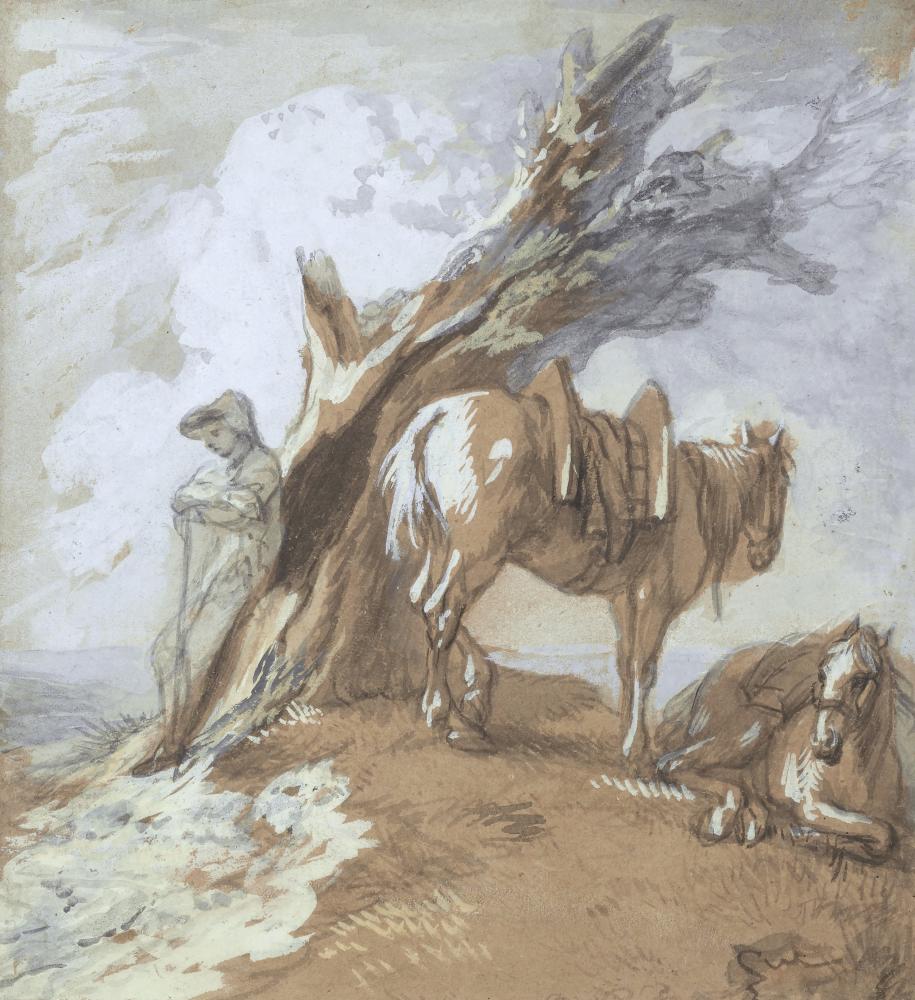THOMAS GAINSBOROUGH R.A.
(1727-1788)
Wooded Landscape with Horsemen by a Pool
Provenance
Guy Bellingham-Smith (1865–1945)
With P. & D. Colnaghi, 1936
Bought from them in 1936 by James Leslie Wright (1862–1954), Haseley House, Warwickshire
By descent to his eldest daughter, Veronica, Mrs Dorian A. Williamson (d. 1976) who bequeathed it to her sister, Hope
Mrs Cecil Keith (1902–83), Sussex
With Agnew’s, 1984
Bought by a Private Collector, USA
Bought by Leger Galleries, 1989
Bought by Ladislaus von Hoffmann (1927–2014), Washington DC
Exhibited
Oxford Arts Club, Drawings by Thomas Gainsborough, 1935 (19)
London, 45 Park Lane, Gainsborough Loan Exhibition, 1936 (53)
Amsterdam, Stedelijk Museum, Twee Eeuwen Engelsche Kunst 1936 (217)
Paris, Musée du Louvre, La Peinture Anglaise des XVIIIéme et XIXéme, 1938 (202)
London, Royal Academy, Exhibition of Masters of British Water-colour: The J. Leslie Wright Collection, 1949 (75)
London, Royal Academy, Drawings by Old Masters, 1953 (446)
Geneva, Musée Rath, L’Aquarelle Anglaise 1750-1850, 1955–56 (64), repr. pl. II
Munich, Residenz, Europäisches Rokoko, The 4th Council of Europe exhibition, 1958 (278)
London, Arts Council, Gainsborough Drawings, 1960–61 (56)
London, Tate Gallery, Thomas Gainsborough, 1980–81 (48) repr.
Paris, Grand Palais, Gainsborough 1727–1788, 1981 (111) repr.
London, Agnew, The Watercolour Collection formed by Mrs Cecil Keith, May 1984, pp. 4, 7–8 (3) repr.
London, Leger Galleries, British Painting, May–June 1989 (8) repr. col.
Literature
Mary Chamot, ‘Gainsborough as a Landscape Painter’, Country Life, LXXIX, 29 February 1936, p. 214
Philip Hendy, ‘Art—Gainsborough and Monet’, The London Mercury, XXXIII, no. 198, April 1936, pp. 626–37, repr. opp. p. 637
Mary Woodall, Gainsborough’s Landscape Drawings, 1936, p. 135, no. 387, pl. 103
Martin Hardie, Water-colour Painting in Britain: I. The Eighteenth Century, 3 vols., London 1966, p. 76
John Hayes, The Drawings of Thomas Gainsborough, 2 vols. London 1970, pp. 14, 100, 291, no. 796, pl. 216
John Hayes and Lindsay Stainton, Gainsborough Drawings, London 1983, p. 14, fig. 11
Evelyn Joll, Agnew’s 1982–1992, privately printed, London 1992, p. 152, pl. 137, illus. colour
David Posnett Leger: A Century of Art Dealing 1892–1992, 1992, p. 77, illus. colour
Thomas Gainsborough is regarded as one of the most extraordinary draughtsman of the eighteenth-century and this sheet is considered to be one of his greatest achievements. The subject of this drawing is everyday—a group of tired horsemen skirt a pool in a wooded landscape at the break of day with a distant hill providing an undulating horizon. The forms are deliberately indistinct, the strokes of pen and brush sparing, though the forms are perfectly realised; the perspective is deep and the atmosphere calm and pensive.
The forms are created with black and grey washes that are brought into focus with black ink carefully applied with the tip of a brush and, once the washes were dry, hooked strokes of black chalk and a little hatching provided further definition to the trees. The faintest of blue washes was used in the top left corner to give further context of time and place to the sheet.
Gainsborough frames the riders between a spindly tree on the right that uses a tangle of strokes to describe the branches and a series of dark concentric marks to underline the framing purpose of the form and contrasts it with the other trees in the drawing. On the left dying trees on the near bank of the pool introduce the beholder into the picture space with the vertical forms contrasting with the horizontal brush strokes in the sky and the reflections in the pool. This drawing was probably produced in the 1780s towards the end of the artist’s life and it was made solely for the artist’s amusement. In subject matter it is similar to a drawing recently acquired by the Ackland Art Museum at Chapel Hill, North Carolina which is more freely drawn and lacks the discipline of composition and the subtlety of handling so evident in the drawing presently on offer.
Contemporary accounts state that Gainsborough used exactly the same approach in his commissioned portraits. In a semi-darkened room the artist would block in the colours making sure that they harmonized perfectly and, letting in a little more light, he would concentrate on the head to form the likeness before moving his attention to the costume and the background. The detail was enough to allow the beholder to use his imagination to complete what the artist did not care to include. This act of ‘focusing’ makes the beholder an active participant as he/she understands the forms and gradually comprehends the artist’s intentions. In exactly the same way, the drawing on offer requires the beholder to stop and think and create the forms that the artist has merely hinted at.
Hugh Belsey


